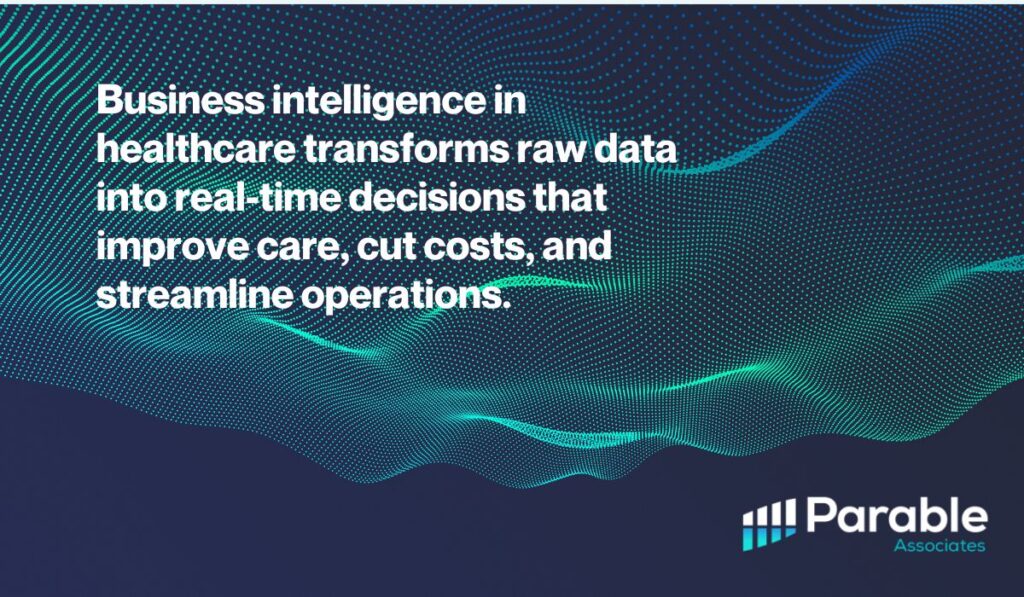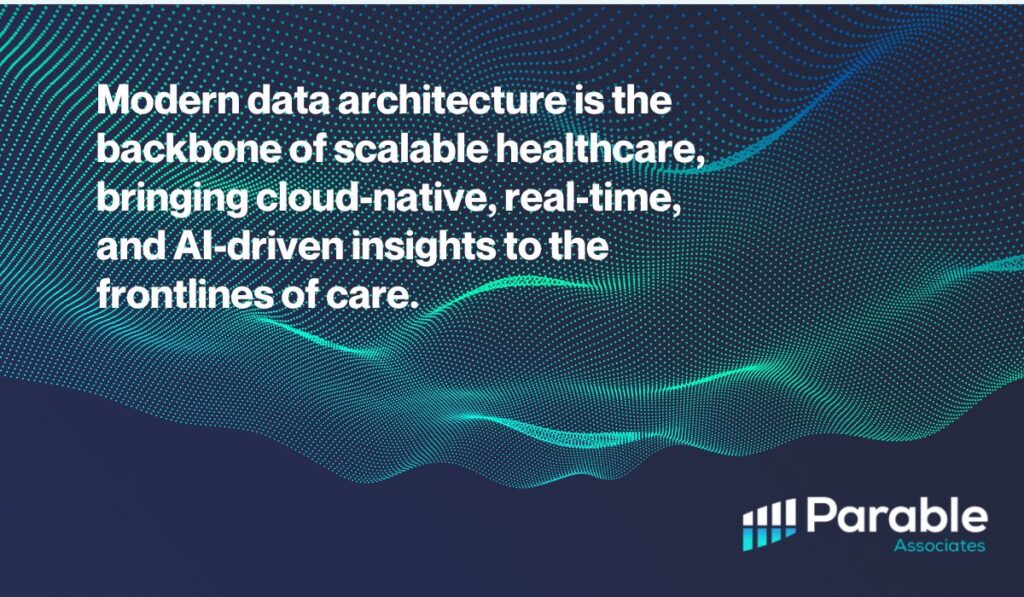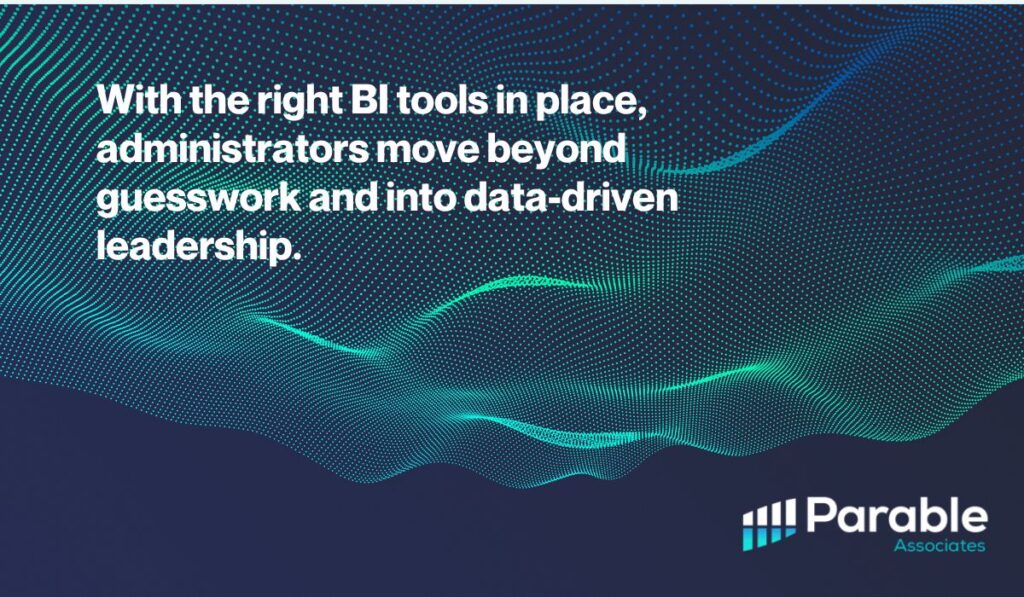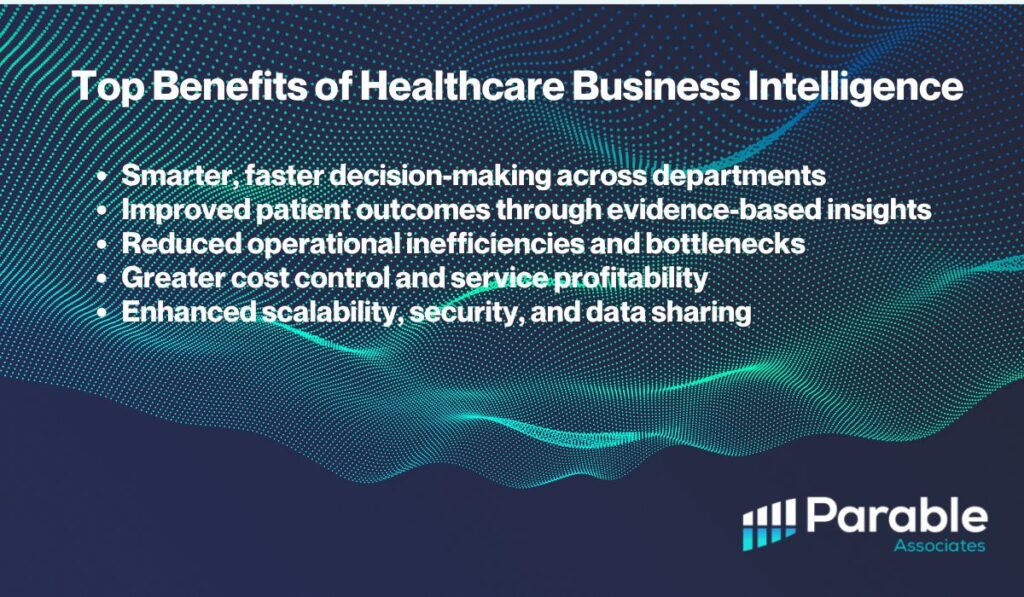In today’s fast-paced, data-driven world, it’s no longer enough for healthcare providers to simply collect patient information. Physicians and practice managers need to interpret that information effectively and extract insights for practice improvement and growth. With so much information coming from multiple sources, this can be an overwhelming task. This is where business intelligence in healthcare comes into play. With the growing need to improve patient care, manage rising operational costs, and stay compliant with ever-evolving regulations, healthcare practices are turning to business intelligence (BI) tools to turn their data into meaningful action.
For practice administrators, the adoption of BI represents more than just a new tool; it’s a strategic shift toward data-informed decision-making. With the right system in place, BI can provide clarity across every aspect of a healthcare organization, from administrative workflows and financial performance to regulatory compliance and patient satisfaction.

Business Intelligence Defined
Business intelligence refers to a suite of tools and methodologies that allow organizations to transform raw data into actionable insights. This process involves collecting, processing, and analyzing data to support better decisions at every level of a medical practice.
For example, instead of relying solely on intuition to forecast staffing needs or identify inefficiencies in patient scheduling, a practice administrator can use BI dashboards to visualize trends and make informed decisions. From tracking patient no-show rates to evaluating referral patterns, BI creates a comprehensive picture of operations, allowing leaders to act with confidence.
Foundational Elements of Business Intelligence
To understand the full scope of business intelligence in healthcare, it’s important to look at the various components and their function. Each plays a unique role in ensuring data accuracy, accessibility, and utility.
ELT: Extract, Load, and Transform
Integrating healthcare information from various systems requires a streamlined and scalable process. One modern approach gaining traction is ELT: Extract, Load, and Transform. Unlike traditional ETL (Extract, Transform, and Load), where data is transformed before it’s loaded into a central system, ELT loads the raw data first and transforms it afterward, providing greater flexibility and speed in high-volume, cloud-based environments.
Extract – Gathering Data from Multiple Systems
The process begins with extracting raw data from the diverse systems a healthcare practice uses daily. These may include:
- Electronic Health Records (EHRs)
- Practice management systems
- Billing and insurance platforms
- Lab, imaging, and diagnostic systems
- Patient feedback and survey tools
- HR systems or external data sources
This step ensures no critical detail is missed. With so many touchpoints generating data, a comprehensive extraction process is essential to break down silos and enable organization-wide visibility.
Load – Centralizing Raw Data for Access and Scalability
After extraction, data is loaded directly into a centralized platform—typically a cloud-based data lake, data warehouse, or analytics environment. This central repository allows practices to consolidate data from multiple departments and technologies into one unified location.
By loading raw data first, healthcare organizations preserve the full detail and structure of the original datasets. This is especially valuable for large, growing practices that require scalable infrastructure and the flexibility to perform different types of analyses later.
Transform – Structuring and Standardizing Data for Analysis
Once the data is in the system, transformation takes place within the central platform. This includes:
- Standardizing formats and terminology (e.g., unifying date structures or medical codes)
- Cleansing and validating records to eliminate duplicates or fill in missing information
- Linking related data sources for deeper context, such as connecting a patient’s visit history with clinical outcomes or insurance coverage
This stage is critical for ensuring the data used in business intelligence tools is accurate, consistent, and actionable. Clean, well-organized data leads to better decision-making, especially in complex environments like healthcare.

Modern Data Architecture – The Next Evolution in Business Intelligence
As the healthcare industry becomes increasingly data-driven, the technology supporting it must evolve just as rapidly. Traditional data warehousing, while once essential, no longer meets the needs of today’s fast-paced, multi-system environments. Enter modern data architecture, aka modern data platform, unified data platform, or lakehouse architecture. It is a flexible, scalable framework designed to support the future of business intelligence.
Rather than relying on static storage systems and complex exports, modern data architecture embraces advanced technologies like cloud computing, real-time processing, and AI to streamline how organizations collect, connect, and act on information. For physicians and practice administrators, this evolution means better performance, greater agility, and deeper, faster insights.
Key Capabilities
Scalability and Flexibility
Modern data environments are built for growth. Whether a practice operates a single location or is scaling to dozens, modern data architecture adapts to shifting demands, handling large data volumes, new data types, and future business requirements without the need for major overhauls.
Cloud-Native Infrastructure
By leveraging cloud platforms, practices gain on-demand access to computing power and storage without the costs of maintaining physical servers. This model allows for pay-as-you-go efficiency while simplifying data backups, updates, and access across geographically dispersed teams.
Real-Time Data Access
Unlike traditional systems that deliver data after the fact, modern architecture supports real-time processing, enabling faster responses to critical business indicators. Whether monitoring clinic throughput or tracking financial performance, administrators get insights exactly when they need them.
Seamless System Integration
Today’s practices rely on multiple platforms—EHRs, billing systems, HR software, patient satisfaction tools, and more. Modern data architecture allows these systems to speak to each other, creating a single, unified view of operations. This promotes data consistency and eliminates redundant workflows.
Hybrid Storage Models
Modern BI systems often combine data lakes (used to store raw, unstructured data) with data warehouses (structured, analytical environments), giving physicians and administrators the flexibility to manage all types of information. This hybrid approach enables deeper analysis without sacrificing speed or organization.
Stronger Data Governance
With more data comes greater responsibility. Modern data architecture puts a strong focus on data quality, security, and compliance, which is especially critical in healthcare, where patient privacy and HIPAA regulations are non-negotiable.

Operational Benefits
Accelerated Insights
Modern BI platforms connect multiple data sources simultaneously, delivering faster, more comprehensive insights. This allows healthcare leaders to understand performance metrics across clinical, operational, and financial areas in one place.
Better Decision-Making
Real-time access to actionable data empowers teams to make smarter decisions faster. Whether adjusting scheduling to reduce wait times or reallocating staff based on live patient flow data, practices can operate with confidence and agility.
Advanced Analytics and Predictive Capabilities
Modern data architecture enables more than just reporting—it supports predictive analytics, machine learning, and AI-powered decision support. This helps organizations identify patterns, anticipate patient needs, and optimize care delivery in ways that were previously impossible.
Innovation Through Data
With greater data accessibility and processing power, practices can pursue data-driven innovation—from enhancing patient engagement to exploring new service lines or operational models based on emerging trends.
A True Competitive Edge
In today’s evolving healthcare market, the practices that can adapt quickly and make well-informed decisions thrive. Implementing a modern data architecture allows for continuous improvement, faster reaction to market shifts, and long-term success.
Data Mining and Discovery
While structured data storage and real-time reporting are essential components of any BI system, the true power of business intelligence in healthcare is unlocked through data mining and discovery. This process goes beyond standard metrics and dashboards—it’s about exploring vast amounts of complex data to uncover hidden relationships, trends, and insights that may not be immediately apparent through traditional analysis.
What Is Data Mining?
Data mining refers to the use of advanced algorithms, statistical models, and machine learning techniques to detect patterns and correlations within large datasets. Unlike basic reporting, which simply summarizes what has already happened, data mining helps organizations predict what is likely to happen next.
In a healthcare setting, this means analyzing millions of data points from electronic health records, claims data, lab results, prescriptions, and scheduling systems to uncover patterns that can inform clinical and operational decisions.
Examples include:
- Identifying correlations between chronic conditions and return patient visits
- Detecting patterns in missed appointments across age groups or geographic locations
- Recognizing emerging trends in medication adherence or treatment response
By applying these methods, business intelligence in healthcare becomes an essential solution to react to trends quickly, prevent future performance risks, and optimize decision-making.
Discovery
Data discovery complements mining by offering a visual and interactive way to explore data. Where mining applies algorithms, discovery empowers practice administrators and department leads to drill into the data for specific insights.
For instance, a practice administrator may use discovery tools to:
- Explore how appointment volumes vary by season, provider, or specialty
- Compare patient satisfaction scores before and after operational changes
- Investigate variations in claims denial rates by insurance provider
Through intuitive drag-and-drop interfaces or guided queries, data discovery tools allow non-technical users to generate meaningful insights without relying on IT teams or data scientists. This democratization of data access is central to the value proposition of business intelligence in healthcare, making data useful and accessible to the people who need it most.

From Insights to Action
The end goal of data mining and discovery is not just to highlight interesting patterns but to drive actionable change. Healthcare practices can use the insights derived from these techniques to:
- Improve care delivery: For example, if data mining reveals that diabetic patients over 65 are more likely to miss follow-up visits in the winter, the practice might implement proactive outreach campaigns in colder months.
- Optimize scheduling: If discovery shows that no-shows spike on Mondays or during certain time blocks, adjustments can be made to appointment strategies or reminders.
- Reduce risk: Predictive analytics might flag patients at high risk for recurring illnesses, enabling early interventions that improve outcomes and reduce costs.
Business intelligence empowers organizations to move from reactive management to proactive leadership, anticipating challenges and addressing them before they escalate.
Data Visualization and Reporting
In the ever-expanding world of healthcare data, numbers alone rarely drive change. To extract real value from analytics, information must be presented in a format that is both meaningful and easy to interpret. Data visualization and reporting transform dense datasets into clear, visual narratives that inform strategy and inspire action.
Visualization and reporting serve as the bridge between technical data systems and real-world decision-making. These tools empower practice administrators to see the big picture at a glance, monitor progress in real-time, and communicate insights across clinical and administrative teams with clarity and precision.
What Is Data Visualization?
Data visualization refers to the graphical representation of data, using tools such as bar charts, line graphs, heat maps, pie charts, and dashboards to convey key metrics and trends. These visuals simplify the interpretation of complex datasets, helping users identify patterns, spot anomalies, and monitor changes over time.
In a healthcare practice, visualization might include:
- A line graph showing patient wait times over the past six months
- A bar chart comparing insurance claim approval rates across payers
- A real-time dashboard tracking provider productivity by day or location
These representations allow administrators to quickly grasp what’s working, what’s not, and where intervention may be needed—all without combing through spreadsheets or raw reports.
Custom Reporting for Targeted Insights
While visualizations provide snapshots, customizable reporting adds depth. Reports allow users to dig into specific data sets, filter by variables, and generate summaries tailored to different audiences or functions. Whether preparing a monthly board presentation or analyzing daily appointment trends, custom reports ensure that decision-makers are equipped with the exact information they need—no more, no less.
In business intelligence in healthcare, reporting can be used to:
- Measure key performance indicators (KPIs) like patient retention or claims turnaround time
- Track compliance metrics required by CMS, payers, or accrediting bodies
- Audit departmental performance and monitor adherence to internal benchmarks
Reports can be generated automatically on set schedules or created ad hoc to answer urgent operational questions.
Why Visualization and Reporting Matter in Healthcare
Healthcare organizations are dynamic, fast-moving environments where decisions often need to be made quickly and collaboratively. Data visualization and reporting tools give the board of directors, executive team, and practice administrators the ability to present real-time data in a format that is digestible for a range of stakeholders, from clinical directors and physicians to front office staff and financial managers.
This accessibility drives:
- Better communication: Easy-to-understand visuals support clearer conversations around goals, challenges, and outcomes.
- Faster decision-making: Real-time dashboards allow administrators to react immediately to trends or performance dips.
- Stronger accountability: Visual benchmarks and scorecards keep teams aligned and focused on shared objectives.
Visualization and reporting act as the lens through which all other BI efforts are understood. Whether the data originates from EHRs, scheduling systems, or patient feedback surveys, these tools make it possible to convert raw information into strategic, results-driven action.
For practice administrators, mastering the use of data visualization and reporting tools isn’t just a technical skill—it’s a leadership imperative. These capabilities enable data to become part of the everyday conversation within a healthcare organization, helping align teams, guide investments, and continuously improve both patient outcomes and operational performance.

The Benefits of Business Intelligence in Healthcare
With a BI system in place, the real value comes from its application. Here’s how business intelligence in healthcare delivers measurable benefits across a practice.
Smarter Decision-Making at Every Level
BI empowers practice administrators to move from reactive to proactive planning. Instead of waiting for problems to surface, administrators can identify risks before they escalate. For example, if the system detects a downward trend in appointment booking or a spike in claim denials, immediate corrective action can be taken. This helps practices stay agile and responsive, fostering a culture of informed leadership.
Better Patient Care Outcomes
By integrating clinical data with operational metrics, BI enables providers to take a more holistic approach to patient care. Administrators can monitor metrics like treatment success rates, wait times, or follow-up compliance, all of which impact patient experience and outcomes. Business intelligence in healthcare supports evidence-based care by helping teams identify which protocols yield the best results and where gaps in care may exist.
Operational Efficiency and Workflow Optimization
Inefficient workflows can drain time and resources, but with BI, practices can pinpoint where delays, duplications, or miscommunications occur. An administrator can analyze check-in processes, room usage, or appointment lengths to optimize staff allocation and reduce patient bottlenecks. This operational lens of healthcare BI ensures that resources are being used effectively without sacrificing the quality of care.
Controlling Costs and Improving Financial Health
Every dollar counts in healthcare management. BI systems allow practices to track overhead, manage budget forecasts, and assess the profitability of specific services. By analyzing the cost-to-revenue ratio of different departments or procedures, administrators can make informed decisions about where to invest or scale back. With business intelligence in healthcare, cost transparency becomes a critical asset in strategic planning.
Enhanced User Adoption
One major challenge in technology adoption is user resistance. However, today’s BI tools are increasingly intuitive, role-based, and customizable. This helps administrators roll out systems that are tailored to each department or user group, promoting higher engagement. By making insights easy to access and understand, BI ensures broader adoption across clinical and administrative teams
Scalability, Customization, and Data Sharing
Whether managing a single-site practice or a multi-location network, scalability is crucial. BI solutions are built to grow alongside the organization, accommodating new data streams and user demands. Additionally, business intelligence in healthcare fosters collaboration by enabling secure data sharing across departments, partners, or affiliate clinics. This interconnectedness supports care coordination, research initiatives, and population health management efforts.
Parable Associates - The Healthcare BI Experts
As practice administrators explore BI implementation, choosing the right partner can make all the difference. Parable Associates stands at the intersection of advanced analytics and deep healthcare expertise. We understand the complexities that come with running a medical practice, from fragmented data and operational inefficiencies to ever-tightening profit margins.
Our tailored approach to business intelligence in healthcare means we don’t just install tools; we deliver solutions. We take the time to understand your practice’s unique goals, whether it’s reducing administrative overhead, improving billing accuracy, or enhancing patient satisfaction.
With a team of healthcare data experts, we ensure your BI implementation is not only technically sound but strategically aligned with your long-term success. From onboarding to optimization, we’re with you every step of the way—turning data into decisions, and decisions into results.
Whether you’re just beginning BI implementation or looking to upgrade your current systems, schedule a consultation today. Working with Parable Associates will allow your practice to operate more efficiently, provide better care, and promote future growth with confidence.
Business Intelligence in Healthcare FAQs
What is business intelligence in healthcare?
Business intelligence in healthcare refers to using data collection, processing, and analysis tools to transform raw information into actionable insights that improve operations, patient care, and financial performance.
How does business intelligence help stakeholders?
BI helps physicians, practice managers, and administrators make informed decisions by providing real-time insights into scheduling, billing, patient satisfaction, compliance, and operational workflows.
What is ELT in modern business intelligence?
ELT stands for Extract, Load, Transform. This modern data integration method involves pulling raw data from various systems, loading it into a centralized platform (often cloud-based), and then transforming it within that system. ELT is ideal for handling large, complex datasets in real time and supports more flexible, scalable BI in healthcare.
How does modern data architecture support healthcare BI?
Modern data architecture replaces traditional data warehousing by offering a more flexible, cloud-based framework. It supports the integration of multiple data types from systems like EHRs, billing platforms, and patient engagement tools. With features like real-time processing, scalable infrastructure, and AI compatibility, it enables healthcare organizations to generate faster, deeper, and more actionable insights.
How does data mining improve healthcare practices?
Data mining uncovers hidden patterns and trends, allowing practices to predict patient behaviors, identify risks early, and optimize operations for better care and efficiency.
What is the role of data discovery in healthcare BI?
Data discovery allows practice administrators and teams to explore datasets interactively, helping them find specific insights without needing technical expertise or IT support.
Why is data visualization important for healthcare practices?
Data visualization simplifies complex information into charts, graphs, and dashboards, making it easier to spot trends, measure performance, and make faster, more informed decisions.
How does business intelligence reduce costs for healthcare practices?
By identifying inefficiencies, tracking overhead, and analyzing service profitability, BI helps practices make better financial decisions and control operational expenses.
Why should healthcare practices partner with a BI expert like Parable Associates?
Parable Associates combines healthcare experience with advanced BI expertise, delivering customized solutions that align with a practice’s clinical, operational, and financial goals.


